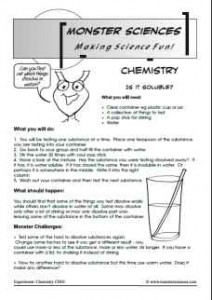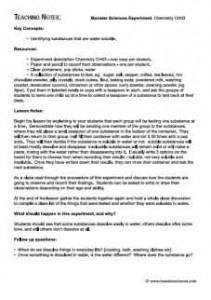Investigate which household products are soluble in water, and how easily they dissolve.
 |
 |
Monster Sciences Experiment About Chemistry: Is it soluble?
What you will need:
• Clear container eg plastic cup or jar
• A collection of things to test
• A pop stick for stirring
• Water
What you will do:
1. You will be testing one substance at a time. Place one teaspoon of the substance you are testing into your container.
2. Go back to your group and half fill the container with water.
3. Stir the water 30 times with your pop stick.
4. Have a look at the mixture. Has the substance you were testing dissolved away? If it has, it is water soluble. If it has stayed the same, then it is insoluble in water. Or perhaps it is somewhere in the middle. Write it into the right column.
5. Wash out your container and then test the next substance.
What should happen:
You should find that some of the things you test dissolve easily, while others don’t dissolve in water at all. Some may dissolve only after a lot of stirring or may only dissolve part way, leaving some of the substance in the bottom of the container.
Monster Challenges:
• Test some of the hard to dissolve substances again. Change some factors to see if you get a different result – you could use more or less of the substance, more or less water, stir longer. If you have a container with a lid, try shaking it instead of stirring.
• Now try another hard to dissolve substance but this time use warm water. Does it make any difference?
Teaching Notes: Monster Sciences Experiment: Chemistry CH03
Key Concepts:
• Identifying substances that are water soluble.
Resources:
• Experiment description Chemistry CH03 – one copy per student.
• Paper and pencil to record their observations – one per student.
• Clear containers, pop sticks, water
• A collection of substances to test, eg: sugar, salt, pepper, coffee, tea leaves, hot chocolate powder, jelly crystals, stock cubes, flour, baking soda, powdered milk, washing powder, dessicated coconut, cinnamon or other spices, curry powder, cleaning powder (eg Ajax). I put them in labelled bowls or cups with a teaspoon in each, and ask the groups of students to send one child up at a time to collect a teaspoon of a substance to test back at their desk.
Lesson Notes:
Begin the lesson by explaining to your students that each group will be testing one substance at a time. Demonstrate how they will be sending one member of the group to the substances, where they will place a level teaspoon of one substance in the bottom of the container. They will then return to their group, half fill their container with water and stir it 30 times with a pop stick. They will then decide if the substance is soluble in water or not: soluble substances will at least mostly dissolve and disappear, insoluable substances will remain solid or will make a paste, mixing with the water rather than disappearing into it. I usually write 3 options on the board for them to choose from when recording their results – soluble, not very soluble and insoluble. Once they have written down their results, they can rinse their container and test the next substance.
As a class read through the proceedure of this experiment and discuss how the students are going to observe and record their findings. Students can be asked to write or draw their observations depending on their age and ability.
At the end of the lesson gather the students together again and hold a whole class discussion to compile a class list of the things that were tested and whether they were soluable in water.
What should happen in this experiment, and why?
Students should see that some substances dissolve easily in water, others dissolve after some time, and still others don’t dissolve at all.
Follow up questions:
• When do we dissolve things in everyday life? [cooking, bath, washing clothes etc]
• Once something is dissolved in water, is the water different? Where does the substance go?



